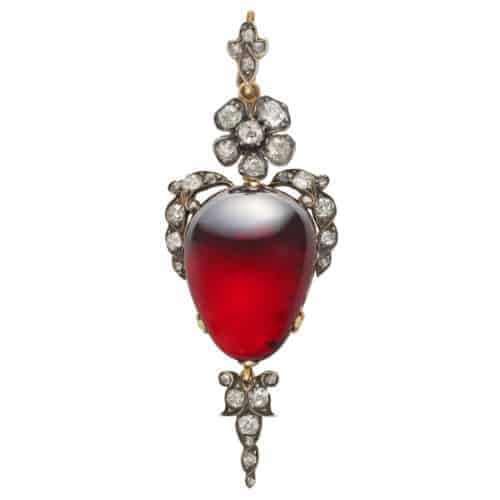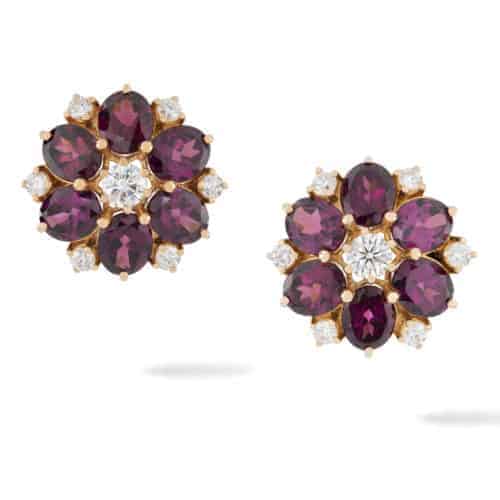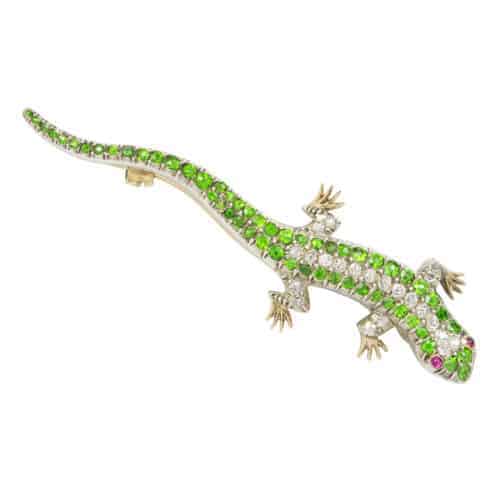January Birthstone – Garnet


A Victorian Garnet And Diamond Flower Pendant
Image Credit: Bentley & Skinner
The name garnet comes from the Latin word ‘granatus’ meaning ‘seeds’ – clusters of garnet crystals resemble the red seeds inside a pomegranate. However, garnets are a set of closely related minerals that form a group, resulting in gemstones of almost every colour. The name garnet refers to this group of minerals related in composition and crystal structure, but with interchangeable elements.
There are more than 20 garnet categories, called species, but only five are commercially important as gems. Those five are pyrope, almandine, spessartine, grossular (grossularite) and andradite. Garnet is rarely pure as many are a mixture of the species.
Pyrope
Red, yellowish red and purplish red, red colour caused by iron, usually with addition of chromium. The name comes from the Greek ‘pyrops’ meaning fiery.
Originally found in Bohemia (Czech Republic), large quantities of Victorian jewellery were produced during the end of the 19th century with pyrope garnets. Usually rose-cut in clusters around a larger central cabochon of stars and crescent designs, they were in the form of necklaces, pendants, brooches, bangles and even hair ornaments. They were made with gilt metal… so not expensive.
Almandine
The division between pyrope and almandine is arbitrary; generally almandine is a darker brownish red to purplish-red, or pale to deep mauve. It is the most common of the garnet species.
Rhodolite
Garnets with a distinct intense raspberry red colour are called rhodolite. A compositional mixture of almandine and pyrope, the name is from the Greek word ‘rhodon’ meaning rose-coloured. It’s a gemstone used by the finest jewellers from Faberge to Tiffany and Chaumet.
A Pair Of Garnet And Diamond Earrings
Image Credit: Bentley & Skinner
Spessartine
Also known as Mandarin garnet, this stone is distinctive thanks to its bright ‘Fanta’ orange, with amazing brilliance. The addition of iron makes it darker or red, brownish red; the unique red-orange colour is produced by manganese. Those sourced from Namibia are the most valuable and, like rhodolite, are a popular choice for top jewellery designers.
Hessonite garnet
Hessonite is the orange-brown variety of grossular garnet (which comes in a range of colours). Hessonite’s colour is due to manganese and iron inclusions.
Green Grossular
The name ‘grossular’ is derived from the botanical name for gooseberry, R.grossularia. There are two varieties of green grossular: Transvaal jade and Tsavourite green grossular garnet. They can be bright bluish green to yellowish green, coloured by vanadium, sometimes chromium.
A Gold And Green Grossular Garnet Grasshopper Brooch
Image Credit: Bentley & Skinner
Adradite group
Demantoid garnet belongs to this group and is the most valuable of the garnet species. Its stunning emerald-green, yellow-green (rarely yellow) vibrant colour is caused by chromium. Usually, the more intense green the colour, the more valuable. These gemstones have characteristic ‘horsetail’ inclusions (or curving fibres) which aid identification and so do not detract from their value. Demantoid garnet display a ‘fire’ (flashes of the spectral colours of the rainbow) which is higher than diamond but is masked by the green body colour. They are found in the Ural mountains of Russia, as well as Namibia and Madagascar.
A Victorian Garnet And Diamond Lizard Brooch
Image Credit: Bentley & Skinner
In the late 19th this gemstone was most suitably used in Victorian and Belle Epoque jewellery celebrating nature; they’re often seen in lizard brooches – the Roman symbol of wedded bliss. Demantoid garnet adds to the beauty and realism like no other.
History, lore and antique jewellery
Thousands of years ago red garnet necklaces adorned the necks of Egypt’s pharaohs and were entombed with their mummified corpses as prized possessions for the afterlife. In ancient Rome, signet rings with carved garnets were used to stamp the wax that secured important documents. Garnet was revered as a spiritual stone of higher thinking and self-empowerment, a stone of strength and safety. In the Middle Ages red garnet was favoured by the clergy and nobility.
The term ‘carbuncle’ was often used in ancient times to refer to red garnets, although it was used for almost any red stone. A carbuncle was thought to be one of the four precious stones given to King Solomon by God.
Red garnet’s availability increased with the discovery of the famous Bohemian garnet deposits in central Europe around 1500. This source became the nucleus of a regional jewellery industry that reached its peak in the late 1800s.
With a hardness of 7 – 7.5 on Moh’s scale, garnet’s durability makes it ideal for use in all jewellery. Today the gemstone is sourced from around the world and besides celebrating the month of January, it can be given as a symbol of luck, health, loyalty and friendship on a second wedding anniversary.








